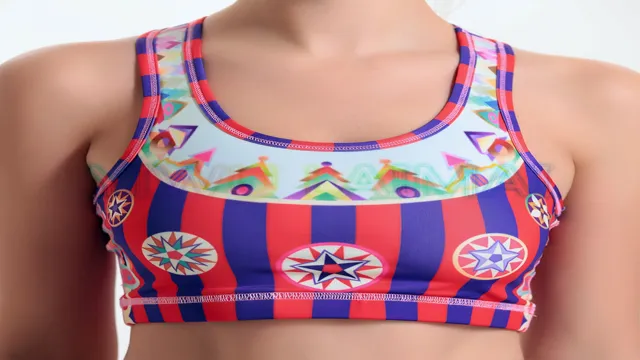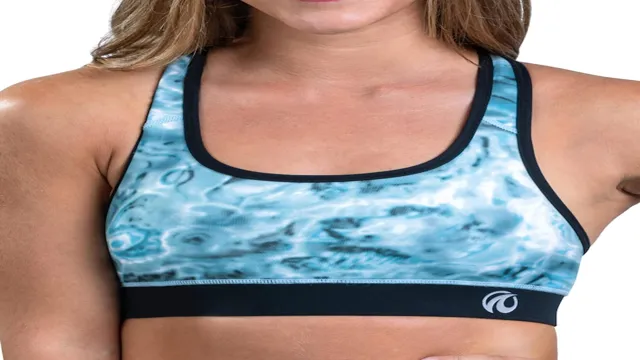
Looking for the perfect sports bra to wear for swimming can be a challenge, especially if you’re new to aquatic activities. But fret not because we’ve got you covered! In this blog, we’ll delve into everything you need to know about sports bras for swimming, from what they are to why they’re essential, and how to choose the best one based on your body type and needs. Whether you’re planning to do laps, take a dive, or join a water aerobics class, wearing a sports bra that fits you well and provides the right amount of support can make a world of difference in your performance and comfort.
So, let’s dive in and learn more about this swimwear essential.
Swimming Attire 101
Many women question whether a sports bra can be worn for swimming, and the answer is a bit complicated. While sports bras are designed to provide support during physical activities, they are not necessarily made for swimming. Sports bras do not have the same water-repellent properties as swimwear and can become extremely heavy when wet, weighing you down in the water.
The fabric of sports bras can also become damaged and stretched out from the chlorine and saltwater found in pools and oceans. Additionally, sports bras are not always built for the oil and sunscreen chemicals that can be found in pools, causing the fabric to deteriorate at a faster rate. Therefore, it is not recommended to wear a sports bra for swimming.
Instead, invest in swimwear that is designed to handle the harsh chemicals and activities associated with swimming. Your swimsuit will keep you comfortable and provide the optimal support you need to enjoy your time in the water.
From Bikinis to Full-body Suits
Swimming attire has evolved significantly over the years. From the 1900s, where women wore one-piece swimsuits that covered their entire legs and arms to the 1930s, where two-piece swimsuits became a trend, and eventually, bikinis in the 1960s. Nowadays, there are numerous options for swimming attire, ranging from bikinis to full-body suits.
Choosing the ideal swimming attire can be overwhelming, but it all depends on personal preference and the type of swimming activity you’re participating in. Bikinis remain popular among many women due to their attractive and flattering nature. They offer minimal coverage, making them ideal for sunbathing, pool parties, and beach activities.
However, full-body suits are gradually gaining popularity due to their practicality, comfort, and protection against UV rays. These suits offer maximum coverage and are ideal for water sports such as surfing, paddleboarding, and kayaking. It’s essential to consider the material used when purchasing a swimming suit to ensure its durability, flexibility, and resistance to chlorine and other chemicals.
Nylon, spandex, and polyester are the most common materials used to make swimsuits, and each has its advantages. Overall, choosing the right swimming attire is all about personal preference, comfort, and practicality. Remember, finding a swimsuit that you feel confident and comfortable in is essential.
So, take your time and find the ideal swimming attire that suits you.

The Pros and Cons of Wearing a Sports Bra
While sports bras are great for exercising and active pursuits, they may not be the best option for swimming. The fabric used in most sports bras is not designed to handle the harsh chemicals found in pools or ocean water. Additionally, sports bras are typically not as form-fitting as traditional swimsuits, which can lead to discomfort and chafing during prolonged exposure to water.
That being said, some sports bras may be suitable for low-impact water activities like paddleboarding or kayaking. As always, it’s important to check the label and ensure that the bra is made from materials that can withstand exposure to water and that it provides enough support for your activity level. So, while you may be able to wear a sports bra for swimming in certain cases, it’s generally best to stick to swimwear specifically designed for water activities to ensure comfort and functionality.
Support vs. Style
Sports Bra As women, we’ve all been in that struggle of finding the right bra that not only looks great but also provides the necessary support during exercise. That’s where sports bras come in. A good sports bra can not only prevent breast discomfort but also minimize the risk of long-term breast damage.
However, not all sports bras are created equal. While some sports bras prioritize support, others prioritize style. It’s essential to consider the pros and cons of each before making a purchase.
A high-support sports bra may not be the most aesthetically appealing, but it will keep your breasts in place during high-intensity workouts. On the other hand, a stylish sports bra may not offer as much support but can be comfortable enough for low-intensity workouts. Ultimately, it’s about finding a balance that works for you.
Whether it’s a high-support, low-support, or stylish sports bra, the main keyword is finding one that suits your individual needs and preferences.
Moisture-wicking Fabric vs. Water-absorbent Fabric
When it comes to wearing a sports bra, it’s important to consider the type of fabric. Moisture-wicking and water-absorbent fabrics both have their pros and cons. Moisture-wicking fabric helps to draw sweat away from the skin, keeping you cool and dry during your workout.
This is especially beneficial for high-intensity activities or hot weather conditions. However, moisture-wicking fabric may not absorb moisture as well as water-absorbent fabric, leading to an unpleasant odor over time. On the other hand, water-absorbent fabric may hold onto sweat, making it heavier and more uncomfortable as you exercise.
It’s important to choose the type of fabric based on your individual needs and preferences, as well as the type of exercise you plan on doing. Ultimately, finding a sports bra that fits well and provides adequate support should be the top priority when selecting workout gear.
Considerations for Choosing a Sports Bra for Swimming
If you’re wondering if you can wear a sports bra for swimming, the answer is not a straightforward yes or no. While some sports bras may be made of materials that can withstand water, it’s important to consider the intended use and design of the bra. Most sports bras for land-based activities may not offer enough support or compression in water, which means they may not be comfortable or supportive enough for swimming.
Additionally, chlorine and saltwater can be harsh on some fabrics and may cause damage over time. However, there are some sports bras that are specifically designed for swimming, with features such as chlorine-resistant material, quick-drying fabric, and UV protection. These bras are usually made with more supportive materials that can withstand the pressure and movement of swimming.
When looking for a sports bra for swimming, consider your activity level, chest size, and the type of water you will be swimming in to find the best fit and support for your needs.
Material and Design
When it comes to choosing a sports bra for swimming, there are a few things you should keep in mind. Firstly, the material is critical. Look for a bra that is made from a quick-drying material that won’t sag or become see-through when wet.
This will allow you to swim with confidence and without any distractions. Additionally, the design of the bra is also important. Make sure you choose a bra that provides adequate support and coverage for your body type.
The last thing you want is to be constantly adjusting your bra during your swim. Consider opting for a bra with wider straps and a comfortable, secure fit to ensure maximum comfort and support. By prioritizing material and design, you can find the perfect sports bra for your swimming needs.
Fit and Comfort
When it comes to swimming, finding the perfect sports bra can be challenging. Not only do you want a bra that provides ample support, but it also needs to be comfortable and able to withstand the water. One important consideration is the material of the bra.
Look for a bra that is made of a quick-dry material, such as Lycra or spandex. These materials are water-resistant and will dry quickly, preventing any discomfort caused by a wet bra. It is also important to choose a bra with a comfortable and secure fit.
Look for adjustable straps and back closures to ensure a customizable fit. A bra that is too loose or too tight can lead to irritation or discomfort during your swim. Lastly, consider the style of the bra.
A racerback design will provide optimal support and allow for a full range of motion while swimming. With these considerations in mind, you can find the perfect sports bra for all of your aquatic adventures.
Tips and Precautions
Many women ask whether they can wear a sports bra for swimming. While sports bras are designed to provide support and comfort during physical activity, they may not be suitable for swimming. Sports bras are often made of materials that are not quick-drying, which means they may retain water and become heavy while you swim.
This can be uncomfortable and may even lead to chafing or skin irritation. Additionally, sports bras are not designed to withstand the effects of chlorine and saltwater, which can cause the fabric to degrade over time. This can cause the bra to lose its shape and support, as well as pose a risk of exposure.
Therefore, it’s best to wear a swimsuit that is specifically designed for swimming and offers support where you need it most. If you’re looking for a more secure and comfortable fit, consider trying a swimsuit with a built-in bra or a swim bra that can be worn underneath your swimsuit.
Rinse and Dry Thoroughly
When it comes to washing dishes, it is important to not only clean them properly but also to rinse and dry them thoroughly. This step is often skipped or rushed, leading to spots, streaks, and, worst of all, bacteria growth. To ensure your dishes are completely sanitized and ready for the next use, there are a few tips and precautions to keep in mind.
Firstly, make sure you use hot water throughout the rinsing process. Hot water helps to kill any remaining bacteria that may be present on the surface of your dishes. Additionally, be sure to use a clean and sanitized sink or basin for rinsing.
Any leftover food particles or debris can contaminate your dishes, so it is essential to clean the sink before use. When it comes to drying, it’s best to use a clean towel or air-dry them. However, if you choose to air-dry, make sure to place the dishes in a well-ventilated area and avoid stacking them.
Stacking the dishes can trap moisture and lead to mold or bacteria growth. By following these simple tips and precautions, you can ensure that your dishes are not only clean, but completely sanitized and safe to use again. So, take the extra time to rinse and dry your dishes thoroughly, your health is worth it.
Wash and Rotate Your Sports Bra
Taking care of your sports bra is crucial to prolong its lifespan and performance. One important tip in maintaining its quality is to wash and rotate it regularly. When washing, use a gentle detergent and cold water to avoid damaging the fabric and elastic band.
Once it’s clean, hang it to dry instead of putting it in the dryer. Don’t forget to rotate your sports bras, so they wear out evenly. Wearing the same bra every day can stretch out the elastic, causing it to lose support and shape faster.
Another thing to keep in mind is to avoid using fabric softeners as they can clog up the fabric’s moisture-wicking abilities. With proper care and maintenance, your sports bra can provide you with the support and comfort you need during your workouts.
Check the Pool Rules
When it comes to swimming, one of the most important things to keep in mind is to follow the rules. Before you jump into the pool, make sure you familiarize yourself with the guidelines and regulations of the facility. Different pools may have different rules, so it’s best to ask the staff or check the signage posted around the area.
One essential rule is to never swim alone. Always have a buddy with you, and make sure that they are aware of your presence in the water. Another important thing to keep in mind is to stay hydrated.
Drink plenty of water before and after swimming to prevent dehydration. Additionally, it’s best to wear appropriate swimwear and accessories when you hit the pool. Avoid wearing clothing or jewelry that could pose a safety hazard, such as loose-fitting clothes or sharp accessories.
By following these tips and precautions, you will have a safe and enjoyable swimming experience. So, remember to check the pool rules and swim safely!
Conclusion
In conclusion, while it may be tempting to don a sports bra for your next dip in the pool, it’s important to remember that these bras aren’t designed for swimming. Not only can they become uncomfortable and potentially cause chafing, but they may not provide the necessary support and coverage that a proper bathing suit or swimwear can offer. So, ladies, unless you’re looking to start a new trend, stick to your trusty swimsuits for your next aquatic adventure!”
FAQs
Is it okay to wear a sports bra for swimming?
While sports bras can be comfortable and supportive for athletic activities, they are not designed for swimming. Chlorine and other chemicals in the pool can damage the fabric and alter the fit of the bra. Additionally, sports bras are not typically made with quick-drying materials, which can cause discomfort and irritation when wet. It is recommended to purchase a swimsuit or bikini top specifically designed for swimming.
Can a sports bra handle the water pressure during swimming?
Sports bras are not made to withstand the water pressure during swimming. They are designed to provide support for low-impact physical activities like yoga, pilates, and weight lifting. Wearing a sports bra for swimming can result in discomfort, chafing, and loss of support.
Can a sports bra affect my performance while swimming?
Yes, a sports bra can significantly affect your performance while swimming. The added drag caused by a non-aquatic sports bra can slow you down, and the lack of support can decrease your speed and endurance. Additionally, a sports bra made of materials not intended for water use can become heavy and uncomfortable, reducing your maneuverability in the water.
Can I wear a sports bra with a swimsuit?
You can wear a sports bra with a swimsuit if you prefer extra support or modesty. However, keep in mind that chlorine and other pool chemicals can damage the bra fabric and cause color fading. It is recommended to wear a swimsuit top designed for swimming to avoid damaging your favorite sports bra.






